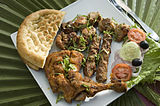Kheer
 A bowl of kheer | |
| Alternative names | Payasam, payesh, ksheeram, doodhpak, meetha bhat |
|---|---|
| Type | Pudding |
| Course | Dessert |
| Place of origin | Southern India |
| Main ingredients | Rice, Milk, Sugar, Cardamom, Jaggery |
| Variations | Barley kheer, kaddu ki kheer, paal (milk), payasam, payesh, chhanar payesh (payesh made with chhana or paneer), Sevai kheer |
| 249 kcal (1043 kJ) | |
Kheer, also known as payasam or payesh, is a pudding popular in South Asia, usually made by boiling milk, sugar or jaggery, and rice. It can be additionally flavoured with dried fruits, nuts, cardamom and saffron. Instead of rice, it may contain cracked wheat, vermicelli (sevai), sago or tapioca (sabudana).[1]
In Southern India, it is known as payasam and it is made in various ways. The most popular versions are the ones made with rice and vermicelli (semiya). [1]
Etymology
[edit]The word kheer is derived from the Sanskrit word kshira (क्षीर), which means milk or a milk-based dish.[2][3] Kheer is also the archaic name for sweet rice pudding.[4]
The word payasam used in South India for kheer originates from the Sanskrit term pāyasa (पायस), which means "milk" or a dish made from milk. This term evolved into various regional languages, including Malayalam (പായസം, pāyasaṁ), Telugu (పాయసం, pāyasaṁ), and Tamil (பாயசம், pāyacam).[5]
Origin
[edit]It is said to have originated initially in South India thousands of years ago. The story is titled "The Legend of Chessboard" in Kerala, an old sage in the form of Krishna challenged the king of Ambalapuzha (chess enthusiasts) to play chess. To motivate the sage, the king offered anything that the sage would name. The sage modestly asked just for a few grains of rice but under one condition: the king has to put a single grain of rice on the first chess square and double it on every subsequent one.
Lord Krishna (the sage) won the game and the king started placing the grains. As he stacked them, he was shocked to see the number grow exponentially. In the end, the number came up to trillions. Krishna reveals himself and asks the king to provide kheer to every pilgrim who comes to his temple there. The Ambalapuzha Krishna temple still follows this and it is located in Kerala's Alappuzha district.[6]
According to the food historian K. T. Achaya, kheer or payasam, as it is known in southern India, was a popular dish in ancient India. First mentioned in ancient Indian literature, it was a mixture of rice, milk and sugar, a formula that has endured for over two thousand years. Payasam was also a staple Hindu temple food, in particular, and it is served as Prasāda to devotees in temples.[7]
Gallery
[edit]-
Kheer topped with dried fruits and nuts
-
Kheer
-
Paal payasam
-
Kheer with vermicelli (called seviyan kheer, semiya payasam or shemai)
-
Vermicelli kheer
See also
[edit]- Porridge
- Phirni – a dessert made with ground rice or rice flour cooked in milk and eaten chilled
- Shir Berenj – Persian rice pudding
- Doodhpak – Gujarati rice pudding
- Shemai – Bengali vermicelli pudding
- Sheer khurma – Persian vermicelli pudding
References
[edit]- ^ a b "Best rated puddings in the world". www.tasteatlas.com.
- ^ Monier-Williams, Sir Monier (1872). A Sanskṛit-English Dictionary Etymologically and Philologically Arranged: With Special Reference to Greek, Latin, Gothic, German, Anglo-Saxon, and Other Cognate Indo-European Languages. Clarendon Press.
- ^ "Kheer: An Essential Dish | Civilization of India". people.smu.edu. Retrieved 10 September 2024.
- ^ "DS group enters dairy market, with 'ksheer' - Hindustan Times". 20 December 2013. Archived from the original on 20 December 2013. Retrieved 10 September 2024.
- ^ "payasam". Oxford English Dictionary.
- ^ "History of Indian Food". Haldiram USA. 24 June 2020. Retrieved 25 April 2024.
- ^ "A truly international dessert". Hindustan Times. 3 October 2009.
- Pakistani rice dishes
- Bangladeshi rice dishes
- Indian rice dishes
- North Indian cuisine
- Muhajir cuisine
- Bihari cuisine
- Uttar Pradeshi cuisine
- Indian desserts
- Nepalese cuisine
- Bangladeshi desserts
- Odia cuisine
- Rice pudding
- Telangana cuisine
- Hyderabadi cuisine
- Punjabi cuisine
- Fijian desserts
- Kerala cuisine
- Tamil cuisine
- Indian cuisine
- Pakistani cuisine
- Sri Lankan cuisine
- Indo-Caribbean cuisine






